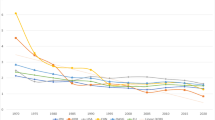Abstract
Regional tendencies in higher education are increasingly important, for example the common rise of North-East Asian universities in China, Hong Kong SAR, Taiwan and South Korea, and Singapore in South-East Asia, to a major global role, following the prior trajectory of Japan. Though the rapidly modernizing Post-Confucian countries do not constitute a formal region, they share a common political and cultural dynamism, entailing rapid improvement of quantity and quality in education and research. This poses challenges and opportunities for Australia, a British/European heritage nation located at the edge of Asia, with extensive trade into East Asia, and an Asian-influenced demography, providing that it can (1) further develop its research capacity, given that research provides the main medium of deep collaboration in higher education, and (2) lift its cultural capacity to interface with systems in the region.



Similar content being viewed by others
Notes
The author previously used the term ‘Confucian Model’ (Marginson 2011b). However, ‘Confucian’ carries unintended meanings reflecting prior usage in terms of fixed cultural categories. Cultural identity in higher education in East Asia (like elsewhere) is not fixed, but continually evolving, and hybrid in character.
The citation data are provided in both raw form and on a field-normalized basis, whereby the Leiden group adjusts the raw data to account for different rates of publication and citation in research fields.
References
Academic Ranking of World Universities, ARWU. (2014). Shanghai Jiao Tong University Graduate School of Education. http://www.shanghairanking.com/index.html.
Asian Development Bank, ADB. (2010). Key indicators for Asia and the Pacific 2009. Manila: ADB.
Australian Bureau of Statistics, ABS. (2013a). Population Clock. http://www.abs.gov.au/ausstats/abs@.nsf/0/1647509ef7e25faaca2568a900154b63?opendocument.
Australian Bureau of Statistics, ABS. (2013b). Reflecting a nation: Stories from the 2011 census, 2012–2013. ABS Catalogue Number 2071.0. http://www.abs.gov.au/ausstats/abs@.nsf/Lookup/2071.0main+features902012-2013.
Australian Government. (2012). Australia in the Asian Century (the Henry report). http://www.asiaeducation.edu.au/verve/_resources/australia-in-the-asian-century-white-paper.pdf.
Chubb, I. (2013). Science, technology, engineering and mathematics in the national interest. Chief Scientists’ Office, Australian Government. http://www.chiefscientist.gov.au/wp-content/uploads/STEMstrategy290713FINALweb.pdf.
Department of Immigration and Border Protection, DIBP, Australia. (2012). Net Overseas Migration. Canberra: DIBP.
Department of Industry, Innovation, Climate Change, Science, Research and Tertiary Education, DIICCSRTE. (2013). Statistics Publications. http://www.innovation.gov.au/HigherEducation/HigherEducationStatistics/StatisticsPublications/Pages/default.aspx.
Kharas, H., & Gertz, G. (2010). The new global middle class: A cross-over from West to East. In C. Li (Ed.), China’s emerging middle class: Beyond economic transformation. Washington: Brookings Institution Press.
King, R., Marginson, S., & Naidoo, R. (Eds.). (2011). Handbook of higher education and globalization. Cheltenham: Edward Elgar.
Leiden University. (2014). Centre for Science and Technology Studies, CWTS. The Leiden Ranking 2013. http://www.leidenranking.com/default.aspx.
Levin, H. (2011). Teachers College, Columbia University. Conversation with the author. Melbourne, 26 September.
Marginson, S. (2011a). Imagining the global. In R. King, S. Marginson, & R. Naidoo (Eds.), Handbook of higher education and globalization (pp. 10–39). Cheltenham: Edward Elgar.
Marginson, S. (2011b). Higher education in East Asia and Singapore: Rise of the Confucian Model. Higher Education, 61(5), 587–611.
Marginson, S., & Marshman, I. (2013). System and structure. In G. Crowther, S. Marginson, A. Norton, & J. Wells (Eds.), The Dawkins revolution 25 years On (pp. 56–74). Melbourne: Melbourne University Publishing.
National Science Foundation, NSF. (2014). Science and Technology Indicators 2012. National Science Board. http://www.nsf.gov/statistics/seind12/.
Organisation for Economic Cooperation and Development, OECD. (2013). Education at a Glance 2011: OECD indicators. Paris: OECD.
Organization for Economic Cooperation and Development, OECD. (2014). PISA 2012 results in focus. What 15 year olds know and what they can do with what they know. Paris: OECD.
Postiglione, G. (2011). The rise of research universities: The Hong Kong University of Science and Technology. In P. Altbach & J. Salmi (Eds.), The road to academic excellence: The making of world-class research universities (pp. 63–100). Washington: The World Bank.
Shin, J. (2009). Building world-class research university: The Brain Korea 21 project. Higher Education, 58(5), 669–688.
Tu, Wei-Ming. (1996). Introduction. In W.-M. Tu (Ed.), Confucian traditions in East Asian modernity: Moral education and economic culture in Japan and the four mini-dragons. Cambridge: Harvard University Press.
UNESCO. (2014). Institute for Statistics. Tertiary Indicators. http://stats.uis.unesco.org.
Wang, Q., Wang, Q., & Liu, N. (2011). Building world-class universities in China: Shanghai Jiao Tong University. In P. Altbach & J. Salmi (Eds.), The road to academic excellence: The making of world-class research universities (pp. 33–62). Washington: The World Bank.
Author information
Authors and Affiliations
Corresponding author
Rights and permissions
About this article
Cite this article
Marginson, S. The strategic positioning of Australian research universities in the East Asian region. High Educ 70, 265–281 (2015). https://doi.org/10.1007/s10734-014-9839-5
Published:
Issue Date:
DOI: https://doi.org/10.1007/s10734-014-9839-5




